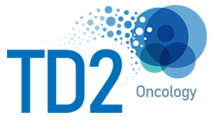Flow cytometry evaluation of cell cycle arrest in A549 human non-small cell lung cancer cells and tumors following treatment with cell cycle inhibitors: A multifaceted approach to targeting cancer
Authors: Erin Trachet, Emily Cluff, Ana Lemos de Matos, Damaris Diaz, Chelsea Holmquist and Paul Gonzales

Abstract: The contemporary landscape of cancer treatment has witnessed significant progress with FDA-approved targeted drugs. The FDA’s Project Optimus has underscored the growing need for innovative pharmacodynamic endpoints to determine the optimal biological dose in clinical development. Flow cytometry, a potent analytical tool in clinical and preclinical labs, now plays a leading role in cancer research, enabling the evaluation of new drug effects on cell cycle regulation and consideration of rational drug combinations with approved drugs. At TD2, we strive to enhance the translatability of in vitro induced cell cycle arrest studies to in vivo biomarker proof of concept and efficacy. We employ a comprehensive approach, utilizing flow cytometry to assess cell cycle dynamics in cultured cells and in vivo tumor models after treatment with approved and novel drugs. This abstract focuses on the translational relevance of combined in vitro and in vivo testing of well-known drugs that disrupt the cell cycle, laying the foundation for optimized treatment strategies and potentially personalized cancer therapies. Human A549 non-small cell lung carcinoma cells were treated with either thymidine (2.0mM) or the microtubule-depolymerizing drug nocodazole (100ng/ml) for 18 hours, then examined by flow cytometry. Thymidine induced a >85% S-phase arrest, while nocodazole induced a >88% G2/M-phase arrest. A549 cells (5×106 cells/mouse) were subcutaneously implanted in SCID mice, followed by treatment with an FDA-approved cell cycle inhibitor, Palbociclib, or cisplatin chemotherapy. Palbociclib, a CDK4/6 inhibitor, and low-dose cisplatin treatment resulted in an increased accumulation of cells in the G0/G1 phase, >80% for each. Both treatments exhibited promising anti-cancer activity, with tumor growth inhibition (TGI) of 69% and 87%, respectively. Our findings highlight flow cytometry’s multifaceted utility in assessing cell cycle arrest, providing a comprehensive view of agent effects on cancer cells in culture and within the complex in vivo tumor microenvironment. Determining the impact of any new drug on specific cell cycle checkpoints could allow for a more strategic plan for combination therapy. Integrating flow cytometry could enable early biomarker monitoring of tumor cell cycle changes, offering insights into the therapeutic potential of new agents alone or in combination. This multidimensional evaluation contributes to understanding cancer biology and has the potential to guide the development of novel therapeutic strategies, optimize treatment regimens to identify optimal biological doses, and improve patient outcomes in the era of precision medicine.
Download Now
CONTACT US
Get Started.
Have questions about how TD2 can assist with your regulatory needs? Reach out to our expert staff today to get started.


